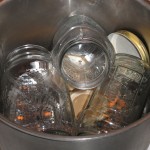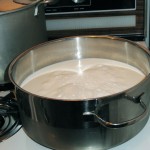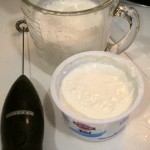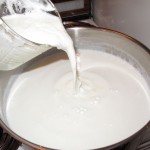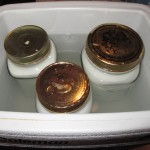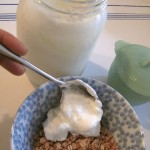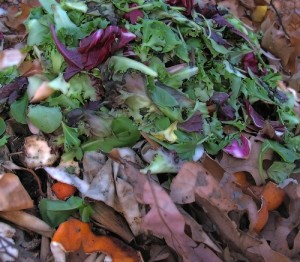Here’s a great video of Patti Moreno, the Garden Girl, showing how easy it is to build a raised bed garden and hoop house. She doesn’t get into it in depth, but she keeps chickens and rabbits in cages over the gardens to help fertilize the soil.
Category Archives: How-To
Make an air conditioner for your chickens
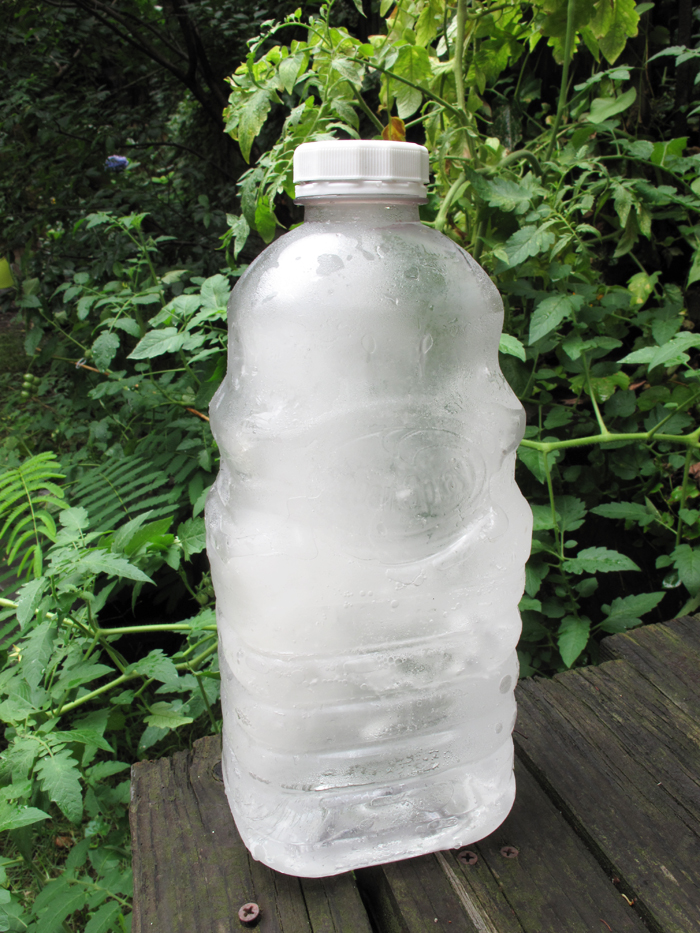
While we are helping birds out this hot summer, let’s think of our backyard chickens. It’s been in the 90s here for the past couple of weeks. The run is in a shady part of my garden, so the girls aren’t bearing the brunt of the heat. However, they are wearing little down coats and have to be feeling it. I’ve been getting fewer eggs on the really hot days, so I decided to try a “redneck air conditioner”. All that consists of is a frozen bottle of water. In this case I used a cranberry juice bottle filled with water. The idea is that you put it in their run and they can sit or lean up against it to cool off.
Make a bird bath
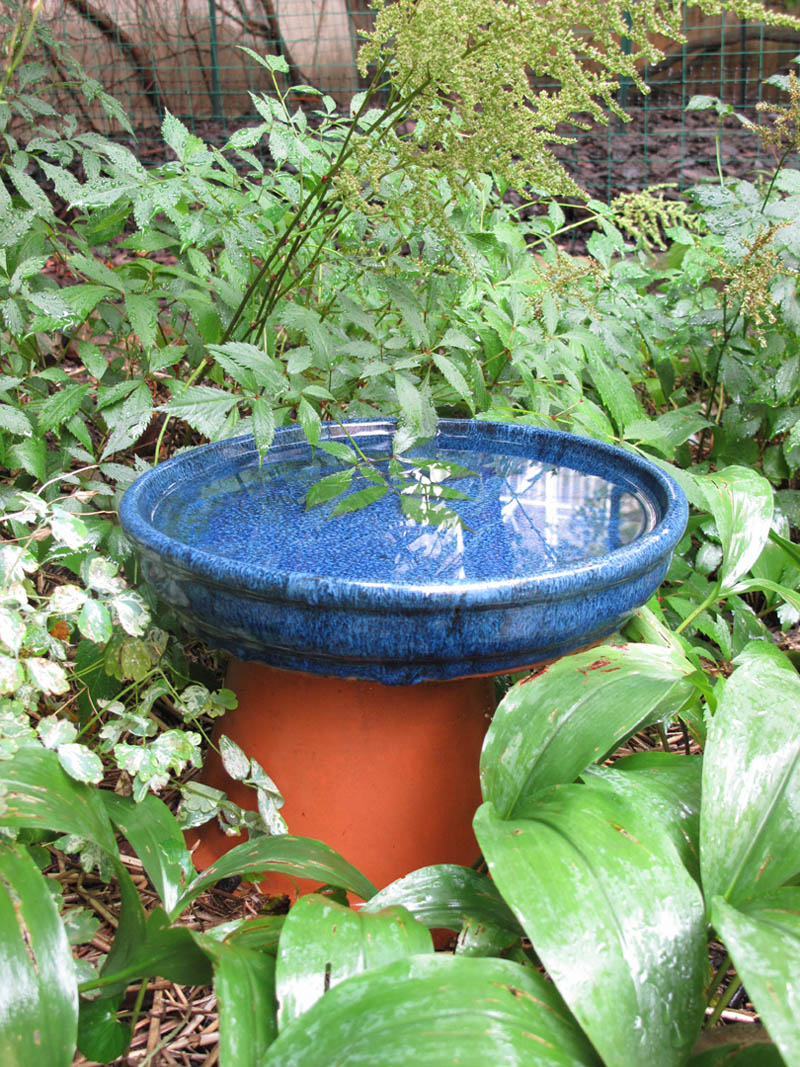
The temperature outside is unbearable, and I can’t remember the last time we had a decent rain. Besides watering your plants (sparingly!) put some water out for the thirsty birds. You can put together a simple birdbath for not a lot of money. Don’t worry about having mosquitoes breed in your birdbath. Mosquitoes need water that hangs around for at least 10 days. You will dump out the old water and add fresh water more often, so you won’t have that problem.
I had been looking around for a nice birdbath for my small Brooklyn garden without much luck. They were too expensive, too ornate or too big. Mostly it was the cost that deterred me. I was in a garden shop this Spring with Neil when we put together the idea for our birdbath. We have a large terra cotta flower pot that we turned upside down. On top of that we put a glazed dish. The dish is actually what you put under a flower pot to catch the water that flows out of the bottom. Nice garden supply centers can carry these in pretty large sizes for a decent price. I think this one was $20 or less. The terra cotta pot is fairly big, so the dish is stable on top of it. I like that it isn’t too high or large and fits into the garden in a very low-key, organic way. We have robins and catbirds coming into the yard to drink and bathe, which is a nice change from the sparrows that usually hang out with us.
How to make yogurt
I’ve been reading my daughter the Little House on the Prairie books lately. What amazes me when I’m reading them is how many different skills people had back then. They raised animals, they built houses out of trees, they gathered honey from hollow trees, they made cheese, soap, maple syrup, beds, clothes, you name it. It seemed as though there was almost nothing they couldn’t do to meet their needs. It seems now that there is almost nothing we can do to meet our needs. Okay, computers, heat, cars and all of that are fantastic inventions, but we’ve become so specialized that things that a child could do during Laura Ingalls’ time seem exotic to us now.
Take cheese making for instance. How many people know how to make their own cheese? Maybe there isn’t enough incentive now that wonderful, artesian cheeses are available in every decent-sized town. We have a great cheese shop in our neighborhood called Stinky. But I digress.
Almost a year ago I started to read up on making cheese. I found the New England Cheese Making Supply Company online and promptly ordered a cheese making kit. They teach you how to make fresh mozzarella in 30 minutes. I tried it and it was delicious. I decided to try yogurt and discovered this site. He errs on the side of caution with heating the milk up, but I decided I would try his method and then I could always scale things back when I was more comfortable with the process.
So let’s make yogurt!
You will need:
1 gallon of milk
1 8oz. container of yogurt that’s unopened
powdered milk (optional)
a big stock pot
enough jars (mason, spaghetti sauce) to hold the gallon + of milk
cooler
• First you want to steam the jars you will be using for about 10 minutes to sterilize them.
• Add a gallon of milk (not ultra pasteurized!) to a big stock pot (with a heavy bottom). You can make your yogurt full fat or lowfat by choosing what kind of milk you use. You can add 4 T of powdered milk to make a thicker yogurt.
• Heat the milk slowly until it reaches about 185-195ºF.
• Place the covered pot in a pan of cold water to cool it down. Again, some people skip these first steps, but this kills any pathogenic (euw!) bacteria that may be hanging around.
• When the milk cools to 122-130ºF, remove it from the cold water bath. Pour 1 cup of the milk into a 2-cup measure.
• Add 1 cup of fresh yogurt until mixture is well-blended.
• Slowly add your yogurt/milk mixture into the rest of the milk and mix well.
• Pour milk mixture into the sterilized jars and cover immediately. One of your jars can be an 8oz. jar that will serve as the fresh yogurt for your next batch.
• Add water that is about 122-130ºF to the cooler. Set the jars in the cooler. The water should be below the level of the lids. Let the jars sit undisturbed for at least 3 hours. If you don’t have a cooler, you can wrap the jars in towels and keep in a warm spot.
Your unopened jars will keep for up to 2 months in the fridge, so you have plenty of time to enjoy this delicious yogurt.
- Steam the jars and lids
- Heat milk to 85-90 C (185-195 F)
- Add fresh yogurt to scalded and cooled milk
- Add yogurt/milk mix to rest of milk
- Keep jars in 50 C water for at least 3 hours
- Enjoy!
Become an Outdoors-Woman in NY State
How funny/cool is this? The New York State Department of Environmental Conservation has classes on teaching women to be self-reliant in the great outdoors.
Becoming an Outdoors-Woman (BOW) and Beyond BOW are programs designed to teach women outdoor skills. These national programs provide women with information, encouragement and hands-on instruction in outdoor skills such as fishing, shooting, archery, hunting, trapping, outdoor photography, map and compass, survival, camping, canoeing and outdoor cooking.
Paddling a kayak
Becoming an Outdoors-Woman workshops are designed primarily for women who have little or no experience with outdoor activities. These are three-day workshops that offer many different classes over the course of a weekend.
Beyond BOW workshops are another opportunity for women to learn outdoor skills and are anything we offer that is not the traditional three-day BOW workshop. They may be “next step” classes for women who have completed a beginner class at a BOW workshop. They may be one day, one subject classes. They may even be an actual hunt, canoe trip or camp-out.
BOW and Beyond BOW workshops are open to anyone aged 18 and over – past participants have ranged in age from late teens to the mid-eighties!
Upcoming BOW workshops:
September 18 – 20, 2009 – Silver Bay YMCA on Lake George, Warren County. Registration materials will be available in June 2009.
Upcoming Beyond BOW Events:
The following Beyond BOW events will take place in the Saranac Lake / Lake Clear region of the Adirondack Mountains. For information on all 2009 Beyond Becoming an Outdoors Woman programs, view or download the 2009 Beyond BOW Schedule (230 KB PDF).
May 29 – 31, 2009 – Beyond BOW
Please choose one class
Cost: Early Bird Registration,
Before January 31st $375*
After February 1st $395*
*Fee includes meals. lodging and instruction.
Firearms in the Forest: Contact Jackie Emslie – (914) -475-4901 or jslie@earthlink.ne
On-Water Canoe/Kayak Interpretive Paddle: Contact Carol Drury (518) 524-2036 or Dryadguide@yahoo.com
Angie Berchielli (518) 797-3747 or AngieBerchielli@MSN.com
Map and Compass: Contact Sheila Young (518) 359-8194 or foothill@capital.net
October 16 – 18, 2009 – Beyond BOW
Please choose one class
Cost: Early Bird Registration,
Before June 30th $375*
After July 1st $395*
* Fee includes meals, lodging and instruction.
On-Water Canoe/Kayak Interpretive Paddle: Contact Carol Drury (518) 524-2036 or Dryadguide@yahoo.com
Angie Berchielli (518) 797-3747 or AngieBerchielli@MSN.com
Adirondack Hiking: Contact Sheila Young (518) 359-8194 or foothill@capital.net
Becoming an Outdoors-Woman Listserv
Sign up for the Becoming an Outdoors-Woman e-mail notification listserve and get notices and registration information for all BOW and Beyond BOW events sent right to your inbox. All you need to do is click on the listserv link below and follow the directions on the screen. You will get a confirming e-mail back. You must respond to the confirming e-mail to activate the e-mail notification service.
Becoming an Outdoors-Woman listserv
For further information on the BOW or Beyond BOW program, contact: NYS Becoming an Outdoors-Woman, 625 Broadway, 5th Floor, Albany, NY 12233-4754 or call (518) 402-8883
Build a worm bin
Here’s a great video from the environmentals about building a worm bin.
The Enviromentals (Episode 1) How to Make a Worm Composting Bin from Hal Brindley on Vimeo.
Compost 101
A lot of people are very interested in composting, but find the process too intimidating. With a few pointers, it’s really very simple. In this lesson I will assume that you have an outdoor space for your compost. We will have a lesson in composting indoors coming up shortly.
How do leaves, berries and other organic matter turn to soil (or compost) in nature? They get rained on and start to decay. What’s the difference between breaking organic matter down at home versus in the wild? Nothing much just some time and energy. If you have a big yard, you can have one or more piles in an out-of-the-way area and let nature slowly break them down. This process could take a year or more depending on what you put on the pile. However, many people don’t have that kind of space or patience.
So let’s assume you have some outdoor space and want a contained pile that will produce rich compost more quickly. There are many online sources to find compost bins. Many cities have compost programs in which they give or sell (at reduced prices) compost bins. This is mutually beneficial because while you get a free or inexpensive compost bin, they don’t have to haul away as much garbage. About 60% of everyone’s garbage consists of organic matter that could be composted. It’s a shame to throw this into a landfill when you could turn it into rich soil for your plants. The New York Sanitation Department has a partnership with the Brooklyn Botanic Garden to subsidize compost bins and classes. This wonderful project is facing the axe of budget cuts unfortunately. The bins are still less expensive than many commercial sites. If you live in the NYC area, you can email them for information about purchasing their bins at compost@bbg.org.
Some online sources for compost bins:
Or, you could build your own:
- Take a galvanized trash can and punch holes in it. This compost bin is the best solution if you are at all worried about attracting rodents.
- Or follow the directions on this website, which shows several different types to build.
The most important thing to remember in the beginning is that the organic material you toss in your compost bin will eventually turn into compost no matter what. Short of shellacking your leaves, there’s really nothing to prevent them from breaking down into soil, so don’t worry about messing up the process. They are going to decay and break down without you, so you don’t need to dig into the nitty gritty too much to compost. If you are type-A like myself, you will want to know about the bacteria and fungi that are involved with the process, but let’s keep things simple for now. We want to get you started and help prevent some common problems.
There’s a whole list of things that you can put into your compost pile, but let’s first talk about what should not go in.
DO NOT ADD:
- Meat or Fish – This will stink and attract rodents.
- Dairy
- Oily foods – Oil coats the food preventing the bacteria from getting to the food and doing their good work.
- Pet feces -Dogs, cats and other meat-eating animals carry a host of diseases that won’t break down in a backyard pile. Some cat litter says it’s compostable and it is if there’s only urine in it. But maybe you shouldn’t even go there.
- Inorganic/manmade materials – Rubber bands, metal twist ties, plastic, metal or anything that will last on the planet longer than our grandchildren.
GOOD TO ADD:
The short answer for what to put in is basically everything else and some water. You can certainly make compost with this much information. The stuff that follows just adds a bit of information to make your scraps turn into soil faster and avoid smells. I’m breaking the good stuff into two parts: green and brown.
Add GREEN materials such as:
- Vegetables
- Fruits
- Grass clippings
- Animal manure – From non-meat eating animals such as horses or chickens. Chicken poop is very high in nitrogen, which makes it an excellent choice
- Coffee grounds
- Bread
- Old flowers
- Weeds – Avoid weeds that have gone to seed as they will flourish in your compost and then grow wherever you spread it in your garden.
Add BROWN materials such as:
- Leaves
- Egg shells
- Sawdust
- Tree branches – Avoid ones that are too big as they will clog up your pile for a very long time.
- Unbleached napkins and paper towels
- Newspaper
- Wood ash – Ash from charcoal shouldn’t be used.
- Lint from the dryer or vacuum cleaner bag
Green materials have a lot of nitrogen in them, which helps them decay faster, but can smell in the process. Brown materials have a lot of carbon in them and take longer to decay, but don’t smell. Try to mix some green materials with some brown materials to give you the best of both worlds. You generally want slightly more browns (60%) than greens (40%), but don’t lose sleep over the ideal proportions. If your compost bin is smelly, add some more material from the brown list.
After you’ve added your kitchen and yard scraps you should add some water and mix everything up. You can use a pitchfork or a more specialized comport crank. I use a compost crank that looks like a giant corkscrew. The ideal wetness of a pile is often described as being as wet as a wrung out sponge. You can decide how often you want to add water and turn the pile. The more often you do, the faster the process will be. But if you go away on vacation, you don’t need to find a compost sitter. The pile will continue to decompose on its own. There are products on the market that claim that they will speed up the process so much, you will have finished compost in 14 days. That’s a bunch of snake oil as far as I’m concerned.
Well, that’s pretty much it. You should have beautiful rich garden soil in about 3-6 months. You will also find plenty of earthworms and other little creepy crawlies. They are big helpers in the process and shouldn’t be seen as pests. When you sprinkle the finished compost on your garden, they will only help to enrich the soil. Have fun with your composting. Spread the word. And bask in the knowledge that you are doing a big part in making your part of the world greener and healthier.

